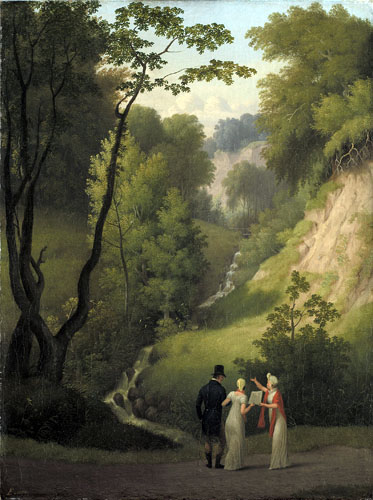| Den romantiske Have

| | I slutningen af 1700-tallet blev en række af de kongelige haver omlagt fra barok stilen til den romantiske stil. Det drejede sig bl.a. om Frederiksberg have og Marienlyst slotshave ved Helsingør
Aristokratiet lod sig også inspirere af den nye havestil. Liselund på Møn er et godt eksempel på dette. |
En ny havetype
Så sent som i 1760erne anlagdes eller omlagdes både Fredensborg, Frederiksberg og Marienlyst haver til barokke haveanlæg i fransk stil med ustrakt orden og symmetri. Blot 30 år senere havde stilen skiftet til en mere landskabelig og oplevelsespræget have. Mens barokkens orden spejlede den kontinentale enevældes tid, så er den engelske, landskabelige have et varsel om nye tider.
Som den eneste af kongehusets slotshaver undgik barokhaven ved Frederiksborg Slot dog at blive omlagt til romantisk landskabshave. Det har formentlig været for vanskeligt og forbundet med store omkostninger at fælde de mange lindealléer og ændre det karakteristiske terrasseformede terræn.
I England fik man tidligt parlamentarisk styre med vægt på den enkeltes rettigheder og selvbestemmelse. Man skal selv kunne orientere sig i landskabet, også det politiske, og der åbnes op for en større, om man vil romantisk, følsomhed, som også er et varsel om en kommende tids borgerstyre.
Frederiksberg Have
En sammenligning af J.C. Kriegers tegning af Frederiksberg Have fra 1760 med Peter Petersens planskitse fra 1795 til en romantisk have samme sted åbenbarer med tydelighed forskellene imellem den barokke og den romantiske have. Mens barokhaven er præget af symmetri og regelmæssighed er det modsatte tilfældet med den romantiske planskitse: De centrale dele af haven er omdannet til et virvar af slyngede stier og vandsystemet er omskabt til et tilfældigt udseende bugtet forløb med tre søer.
Helt tilfældigt er det nu ikke. Alt er iscenesat, men det skal gerne ligne ”den rigtige” natur og den diffuse tilrettelæggelse lægger op til at den besøgende går på opdagelse i haven. Derfor er der også indlagt forskellige overraskelser: Et vandfald, et antikt tempel og den ene ø huser et kinesisk hus og en ditto gangbro. Disse momenter skal som sagt stimulere oplevelsen og stemme sindet følsomt. Frederiksberg Have er de senere år rekonstrueret som romantisk have, bl.a. er vandfaldet, som oprindelig var hestetrukket, genskabt.

Frederiksberg Have | 
Den romantiske have | 
Kongen i Frederiksberg Have. | 
Kinahuset | 
Kineserbroen |

Landskabshaven | 
Vandfaldet i Frederiksborg park |
Marienlysts romantiske have
Marienlyst ved Helsingør var i perioden 1759-64 blevet omskabt til et klassicistisk palæ og i 1667 forsynet med en barokhave i fransk stil. Officielt stod hofmarskal, greve A.G. Moltke som bygherre, men reelt var det kongen, Frederik 5.., der ejede foretagendet. Hans efterfølger Christian 7. benyttede slottet ved nogle enkelte officielle lejligheder, men det overgik snart til hans stedmoder enkedronning Juliane Marie, der lægger navn til det.
En planskitse af den tyske gartner Johan Ludvig Mansas fra omkring 1790 illustrer planerne for et nyt romantisk haveanlæg. I dette tilfælde er der tale om at bygge udenpå den eksisterende have, således at den dramatiske skrænt bagved det eksisterende kommer til som et supplerende anlæg. Det er en udpræget romantisk oplevelseshave som tilføjes eksotiske indslag såsom Hamlets grav og Ophelias kilde. Disse forsætter langt ind i 1800-tallet som seværdigheder for den voksende turistskare. På det seneste har der været tale om at genoprette dele af det romantiske anlæg.

Marienlyst romantiske have |
Liselund
Ikke kun de kongelige, men også formuende aristokrater fattede interesse for den nye havestil. Et eksempel herpå er ægteparret Antoine og Lisa de la Calmette, der skabte det romantiske anlæg omkring Liselund på Møn. Antoine var hollandsk diplomatsøn og ægteparret foretog flere gange dannelsesrejser til Sydeuropa, måske inspireret af englænderen Laurence Sterns beretning om den følsomme rejse til Italien og Frankrig.
Den umiddelbare inspiration kommer formodentlig fra Nordtyskland og i fra 1791 foreligger en planskitse af landskabsmåler M. Westenholdt. Denne indeholder bl.a. forslag til beplantninger med eg og bøg nøje afstemt med omgivelserne og de planlagte byggerier, som udover hovedbygningen Liselund bl.a. omfattede Det norske Hus, Schweizerhytten med tilhørende nåletræer og et kinesisk lysthus med hængeask. Nåletræer er noget forholdsvis nyt og eksotisk og i det hele taget anvendes mange sjældne træarter.

Liselund 1791 | 
Liselunds romantiske have. | 
Liselund | 
Interiør | 
Den romantiske Have |

Landskabshaven | 
Kløften | 
Liselunds Have |
Andre eksempler
Den romantiske have, landskabshaven, oplevelseshaven eller den engelske have bliver altså et modefænomen i slutningen af 1700-tallet. I nogle tilfælde omskabes eksisterende haver, som f.eks. Frederiksberg Have, helt eller delvist, mens i andre tilfælde helt nye romantiske haver anlægges af en række privatpersoner. Haveanlægget skal nu heller ikke blot repræsentere den enevældige statsmagt.
Udover Liselund kan nævnes Dronninggård, senere Næsseslottet, ved Furesøen nord for København, hvor mange velhavende borgerlige erhvervede lystejendomme i den såkaldte florissante periode i slutningen af 1700-tallet, hvor man i Danmark som neutralt land tjente store penge på international transithandel. |